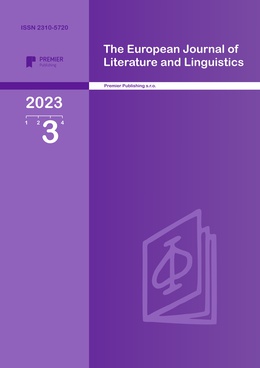Gender representation in English mathematical textbook for 1st grade learners
Authors
Elvira Abdurashitova

Share
Annotation
In this article we have carried out a study of the mathematics textbook for the first graders, currently used in the US, so that we can present the complete picture of how gender is constructed with the help of texts of pedagogical discourse in the minds of primary school children. We offer a fragmented analysis that allows us to identify ways of constructing gender using various semiotic means, as well as the interaction of verbal and non-verbal means. Understanding the textbook as a polycode text allowed us to identify the implicit ways of constructing gender, which exist due to the interaction of the verbal and non-verbal code, as well as the hidden ways that define the algorithm of inferential knowledge, inference
Keywords
Authors
Elvira Abdurashitova

Share
References:
1.Ashurova D. (2010), Communicative-cognitive theory of text. Tashkent.
2. Barchunova T. (1995), Sexism in a primer. Scientific journal "Eco.
3. Berger P. L., Luckmann T. (1967),The Social Construction of Reality: a treatise in the Sociology of Knowledge, N.-Y.
4. Ergasheva G.I. (2018), Applied linguistics: Terminology and Translation through gender discourse lens. Tashkent.
5. Fateeva N.A.(2007), Intertext in the world of texts: counterpoint of intertextuality. Moscow, KomKniga publishing house.
6. Foucault M. (1996), The Will to Truth: Beyond Knowledge, Power and Sexuality. Works of different years. Moscow, Castal publishing house.
7. Gorodnikova M.D. (2002), Gender in communicative interaction. Gender: language, culture, communication: reports of the second International conference. Moscow.
8. Gritsenko E. S. (2005), Language. Gender. Discourse: monograph. Publishing house of NSU named after N.I. Lobachevsky, Novgorod.
9. Guseva Yu. E. (2003),Gender socialization. Workshop on gender psychology, SPb.
10. Karasik V. I. (2002),Linguistic circle: personality, concepts, discourse. Volgograd: Peremena publishing house.
11. Kirilina A. V. (1999), Gender: linguistic aspects. Moscow, Publishing house of the Institute of Sociology of the Russian Academy of Sciences.
12. Kirilina A. V. (2000), Gender aspects of language and communication: Ph.D. thesis: 10.02.19 / Moscow state linguistic university. Moscow.
13. Kirilina A. V. (2004), Gender research in linguistics and theory communication: textbook. manual for university students. Moscow, ROSSPEN.
15. Konovalova S. A. (2005), Gender specificity of the expression of predicative relations in the text of the Russian folk fairy tale: Ph.D. thesis: 10.02.1. Moscow state linguistic university. Moscow.
16. Rosenhan M. (1977 ),Images of Male and Female in Children's Readers. Women in Russia . California, Stanford University Press.


